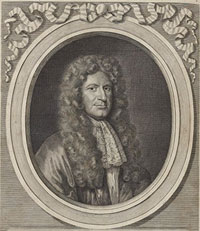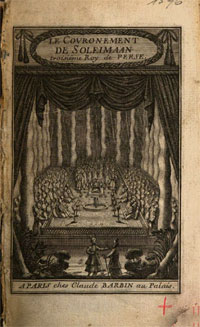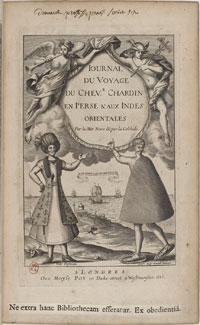



Jean Chardin
Paris 1643 - Chiswick 1713
Jean Chardin, a Huguenot jeweller, travelled twice to Asia (1644-1670 and 1671-1680) for business purposes. There he learned Turkish, Persian and, to a lesser extent, Arabic. Once religious persecution pushed him to leave France for England, Chardin was knighted by Charles II (1681), elected actionist of the English East India Company (1682) and fellow of the Royal Society (1682-1685). About Persia, lying at the heart of his travel experience, Chardin published Le couronemment de Soleïmaan troisième, roy de Perse (1671) and, most importantly, the Voyages de monsieur le chevalier Chardin en Perse, et autres lieux de l’Orient (1711), whose first volume was released in 1686. Best “ethnographer” of the Persian civilization of his time, an advocate of religious tolerance and a supporter of the value of experience over tradition in the pursue of knowledge, in his works Chardin often reveals the intense reading activity hinted at by his library. Among his lost works, some parts of his Notes sur divers Endroits de l’Ecriture Sainte can be found in reverend Thomas Harmer’s Observations on divers Passages of Scripture (1776, 2nd ed.).
Bibliography: Jean Chardin, Voyages du chevalier Chardin en Perse, et autres lieux de l’Orient, par L.-M. Langlès, Paris, Le Normant, 1811; J. Emerson, Chardin, Sir John, in Encyclopædia Iranica, V/4, pp. 327-328; F. Eshghi, Jean Chardin et sa présence dans les grands œuvres des philosophes du XVIIIᵉ siècle en France, thèse de doctorat dirigée par M. J.L. Lecercle, Université de Paris X, 1977; R.W. Ferrier, A Journey to Persia: Jean Chardin’s portrait of a Seventeenth-century empire, London-New York, I.B. Tauris, 1996; L. Labib-Rahman, Sir Jean Chardin, the Great Traveller (1643-1712/13), «Proceedings of the Huguenot Society of London», vol. XXIII, a. 1981-82, pp. 309-318; M. Longino, French travel writing in the Ottoman Empire: Marseilles to Constantinople, 1650-1700, London, Routledge, 2015, pp. 129-144; E.R. Samuel, Gems from the Orient: the Activities of Sir John Chardin (1643-1713) as a diamond importer and East India Merchant, in «Proceedings of the Huguenot Society», n. 27, 2000, pp. 351-368; D. Van der Cruysse, Chardin le Persan, Paris, Fayard, 1998; F. Wolfzettel, Le discours du voyageur: pour une histoire littéraire du récit de voyage en France du Moyen Age au XVIIIe siècle, Paris, Presses Universitaires de France, 1996, pp. 154-161.